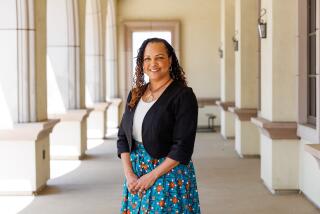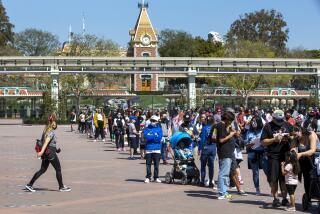Elva Ray Breaks Social Barriers for Her Disabled Students
- Share via
For years, one group of students at Warren High School in Downey did not participate in the adolescent rituals of attending football games and school dances.
The group is known as the H kids,” or orthopedically handicapped. Many of the 31 students are in wheelchairs and suffer from cerebral palsy, epilepsy, muscular dystrophy, blindness or learning disabilities. At least half of these students are confined to one special classroom during the school day and, as a result, have little interaction with other students.
“They’re ignored, they’re dehumanized. As opposed to being laughed at--they don’t exist,” said teacher Elva Ray, speaking about the way she said her students formerly were treated at Warren High.
But Ray has changed that.
A veteran teacher in her first year at Warren, Ray made her disabled students feel more involved with high school life by chaperoning them to three home football games and two school dances last year. She also solicited $730 from the Optimists Club of Downey to bus her students to the Nov. 16 Homecoming Dance aboard the Queen Mary and got the student government leaders to take an active interest in their 31 schoolmates.
Marlyca Bachler, 18, of Paramount, who is blind, recalled her first awkward moments at the dance.
“When I first got there I got all tightened up, I was kind of scared,” she said. “But when I saw all my friends were there, then I calmed down. I just kind of blended in with the group. . . . I loved it.”
Marlyca took fellow handicapped student Brooke Williams, 15, of Downey. “It was tough but I finally got the guts to ask him,” she said.
Another handicapped student, Wade Harrison, 15, of Downey, said that after attending the dance, “I felt good about myself.
“It was getting dressed up. All of it was fun,” Harrison said.
Ray, 50, of Inglewood has been teaching handicapped students for 18 years, working previously at Rancho Los Amigos Hospital in Downey. The Jackson, Miss., native became interested in the disabled after caring for a severely retarded son. Richard, now 22, lives at home.
As part of her campaign to involve disabled students in campus life, Ray went to the student council last spring and asked the group what it could do to help.
Council members responded by adopting the disabled students as pen pals, and sending them daily letters and poems. The council members also gave the disabled students gifts such as homemade muffins, candy and flowers. The campaign of small gestures produced unexpected benefits for both groups of students, Ray said.
“They (student council members) were so accepting and wonderful that my students began to look with glee and anticipation at the beginning of the school day because they wanted to know from whom they were going to get a letter or what the note would say,” she said. “Sometimes the (student council) kids would just line up outside the window and look at the reaction of the (disabled) kids. It became a two-way street. It definitely was reciprocal.”
“I was a little uncomfortable at first,” said Ryan Campbell, president of the Associated Student Body, who recalled his first meeting with the disabled students. “They were a little wary of us and we were a little wary of them. But they’re regular kids like me.”
As a result of increased attention, the disabled students now are more outgoing, school officials said. One disabled student, Shannon Swartz, 15, of Downey, has decided to try out next month for the school’s pep squad. School officials have decided to allow her to participate, Ray said.
“I always wanted to be a cheerleader,” said Swartz, who has cerebral palsy. “I can do everything they can do.”
Another handicapped student, Arthur Lyons, 19, of Compton, ran for student council president last week and finished last out of six candidates with 170 votes.
In an interview this week, Lyons said he ran for office because he thought he could improve the school. He said he also wanted to show that disabled students are as capable as other students.
“I’m not just here visiting everyday, I’m part of the school too,” said Lyons, a paraplegic.
More to Read
Sign up for Essential California
The most important California stories and recommendations in your inbox every morning.
You may occasionally receive promotional content from the Los Angeles Times.













